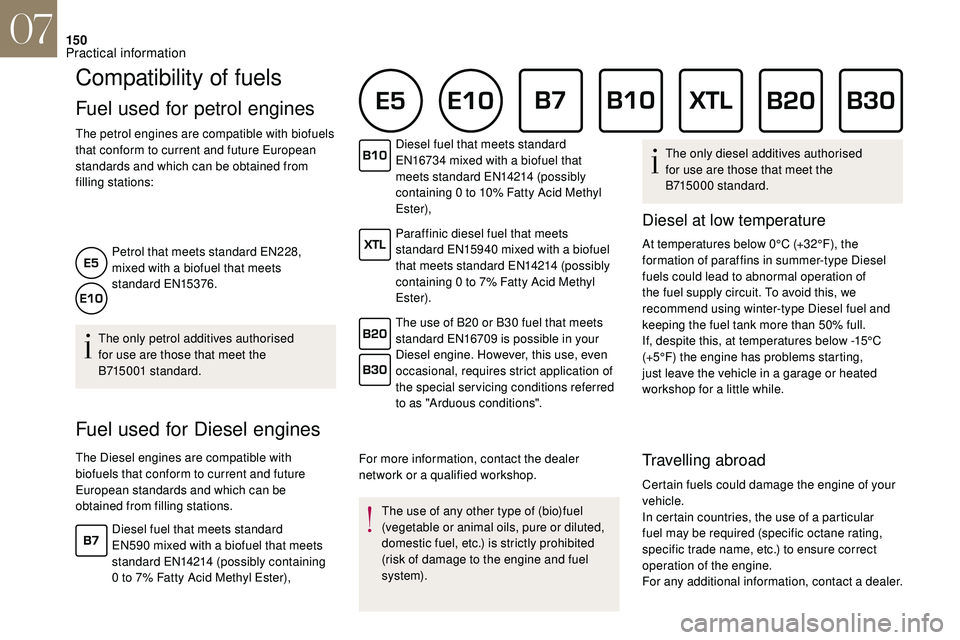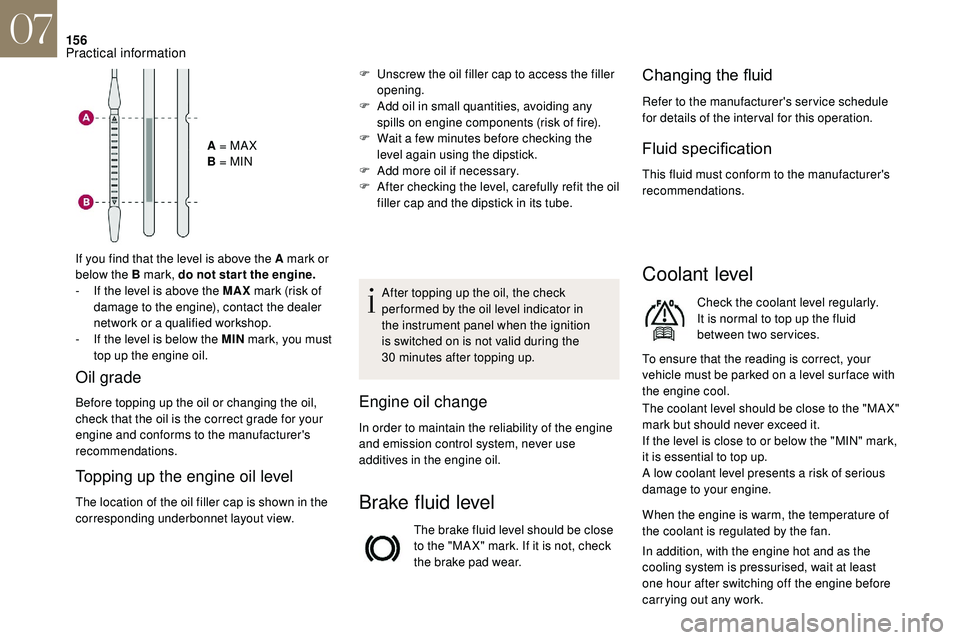oil additives CITROEN DS3 2018 Handbook (in English)
[x] Cancel search | Manufacturer: CITROEN, Model Year: 2018, Model line: DS3, Model: CITROEN DS3 2018Pages: 248, PDF Size: 8.79 MB
Page 152 of 248

150
Compatibility of fuels
Fuel used for petrol engines
The petrol engines are compatible with biofuels
that conform to current and future European
standards and which can be obtained from
filling stations:Petrol that meets standard EN228,
mixed with a
biofuel that meets
standard EN15376.
The only petrol additives authorised
for use are those that meet the
B715001
standard.
Fuel used for Diesel engines
The Diesel engines are compatible with
biofuels that conform to current and future
European standards and which can be
obtained from filling stations. Diesel fuel that meets standard
EN16734
mixed with a biofuel that
meets standard EN14214 (possibly
containing 0 to 10% Fatty Acid Methyl
Ester),
Paraffinic diesel fuel that meets
standard EN15940 mixed with a biofuel
that meets standard EN14214 (possibly
containing 0 to 7% Fatty Acid Methyl
Ester).
The use of B20 or B30 fuel that meets
standard EN16709 is possible in your
Diesel engine. However, this use, even
occasional, requires strict application of
the special servicing conditions referred
to as "Arduous conditions".
For more information, contact the dealer
network or a qualified workshop.
The use of any other type of (bio)fuel
(vegetable or animal oils, pure or diluted,
domestic fuel, etc.) is strictly prohibited
(risk of damage to the engine and fuel
syste m). The only diesel additives authorised
for use are those that meet the
B715000
standard.
Diesel at low temperature
At temperatures below 0°C (+32°F), the
formation of paraffins in summer-type Diesel
fuels could lead to abnormal operation of
the fuel supply circuit. To avoid this, we
recommend using winter-type Diesel fuel and
keeping the fuel tank more than 50% full.
If, despite this, at temperatures below -15°C
(+5°F) the engine has problems starting,
just leave the vehicle in a
garage or heated
workshop for a
little while.
Travelling abroad
Certain fuels could damage the engine of your
vehicle.
In certain countries, the use of a particular
fuel may be required (specific octane rating,
specific trade name, etc.) to ensure correct
operation of the engine.
For any additional information, contact a
dealer.
Diesel fuel that meets standard
EN590
mixed with a
biofuel that meets
standard EN14214
(possibly containing
0
to 7% Fatty Acid Methyl Ester),
07
Practical information
Page 158 of 248

156
A = MA X
B = MIN
If you find that the level is above the A mark or
below the B mark, do not star t the engine.
-
I
f the level is above the MAX mark (risk of
damage to the engine), contact the dealer
network or a
qualified workshop.
-
I
f the level is below the MIN mark, you must
top up the engine oil.
Topping up the engine oil level
The location of the oil filler cap is shown in the
corresponding underbonnet layout view. After topping up the oil, the check
per formed by the oil level indicator in
the instrument panel when the ignition
is switched on is not valid during the
30
minutes after topping up.
Engine oil change
In order to maintain the reliability of the engine
and emission control system, never use
additives in the engine oil.
Brake fluid level
The brake fluid level should be close
to the "MA X" mark. If it is not, check
the brake pad wear.
Changing the fl
uid
Refer to the manufacturer's service schedule
for details of the inter val for this operation.
Fluid specification
This fluid must conform to the manufacturer's
recommendations.
Coolant level
Check the coolant level regularly.
It is normal to top up the fluid
between two services.
To ensure that the reading is correct, your
vehicle must be parked on a
level sur face with
the engine cool.
The coolant level should be close to the "MA X"
mark but should never exceed it.
If the level is close to or below the "MIN" mark,
it is essential to top up.
A low coolant level presents a
risk of serious
damage to your engine.
When the engine is warm, the temperature of
the coolant is regulated by the fan.
F
U
nscrew the oil filler cap to access the filler
opening.
F
A
dd oil in small quantities, avoiding any
spills on engine components (risk of fire).
F
W
ait a
few minutes before checking the
level again using the dipstick.
F
A
dd more oil if necessary.
F
A
fter checking the level, carefully refit the oil
filler cap and the dipstick in its tube.
Oil grade
Before topping up the oil or changing the oil,
check that the oil is the correct grade for your
engine and conforms to the manufacturer's
recommendations.
In addition, with the engine hot and as the
cooling system is pressurised, wait at least
one hour after switching off the engine before
carrying out any work.
07
Practical information